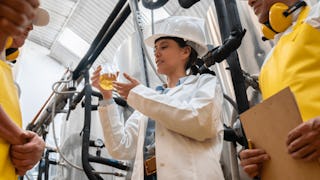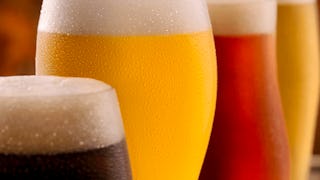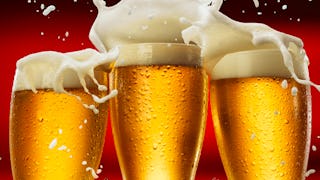Welcome to Beer Quality: Color and Clarity led by distinguished professor Charles Bamforth, Ph.D. In this course, you will learn about beer color and how it impacts a consumer's perception of beer. Also discussed are the scientific factors affecting beer color and clarity. The methods of measuring and altering beer color are presented, as are ways to troubleshoot problems with beer color.
Unlock access to 10,000+ courses with Coursera Plus. Start 7-Day free trial.


您将学到什么
Discover the science behind beer color and clarity, how to measure and assess color, and how to achieve ideal color and clarity in beer.
您将获得的技能
要了解的详细信息

添加到您的领英档案
8 项作业
了解顶级公司的员工如何掌握热门技能

积累特定领域的专业知识
- 向行业专家学习新概念
- 获得对主题或工具的基础理解
- 通过实践项目培养工作相关技能
- 获得可共享的职业证书

该课程共有4个模块
In this module, we begin discussing how beer color and clarity influences the consumer. We'll review some informal research that was conducted regarding consumer perception of beer based on clarity. If you clarify a beer, does it take anything away? We'll discuss this question.
涵盖的内容
5个视频3篇阅读材料1个作业1个讨论话题
In this module, we'll discuss color, some of the basic science behind it, and how humans perceive it. We'll review the Beer-Lambert law equation as well as well as the ASBC and EBC methods of measuring color and look at light absorbance of various beers. Then, we'll review methods and devices used to measure color and discuss what to consider when choosing a method. We'll go over the main source of color in most beers, the Maillard Reaction. And, you'll understand how the oxidation of polyphenols affects beer color, ways of adjusting beer color, and discuss what to do when your beer color is not what you were expecting.
涵盖的内容
7个视频2篇阅读材料2个作业
In this module, we start our discussion regarding turbidity in beer and the role of bits in beer clarity. We'll discuss what invisible haze is and how it affects beer clarity, compare biological haze with non-biological haze, and compare and contrast chill haze with permanent haze. We'll also look at how we measure, interpret turbidity issues, discuss how bits and haze are measured, and touch on the role of microbiology in beer stability.
涵盖的内容
7个视频2篇阅读材料2个作业
In this module, we discuss how grist, hops, malting, and mashing influence beer clarity and stability. We'll also discuss how wort, fermentation, cold conditioning, filtration, stabilizers, and packaging influence clarity and stability. We'll also offer methods of troubleshooting turbidity and touch on beta-glucan, arabinoxylan, starch, oxalate, and dead bacteria. We'll also offer methods of troubleshooting turbidity involving protein, foam stability, and polyphenols.
涵盖的内容
6个视频2篇阅读材料3个作业1个讨论话题
获得职业证书
将此证书添加到您的 LinkedIn 个人资料、简历或履历中。在社交媒体和绩效考核中分享。
位教师

从 Chemistry 浏览更多内容
 状态:免费试用
状态:免费试用University of California, Davis
 状态:免费试用
状态:免费试用University of California, Davis
 状态:免费试用
状态:免费试用University of California, Davis
 状态:免费试用
状态:免费试用University of California, Davis
人们为什么选择 Coursera 来帮助自己实现职业发展




常见问题
To access the course materials, assignments and to earn a Certificate, you will need to purchase the Certificate experience when you enroll in a course. You can try a Free Trial instead, or apply for Financial Aid. The course may offer 'Full Course, No Certificate' instead. This option lets you see all course materials, submit required assessments, and get a final grade. This also means that you will not be able to purchase a Certificate experience.
When you enroll in the course, you get access to all of the courses in the Specialization, and you earn a certificate when you complete the work. Your electronic Certificate will be added to your Accomplishments page - from there, you can print your Certificate or add it to your LinkedIn profile.
Yes. In select learning programs, you can apply for financial aid or a scholarship if you can’t afford the enrollment fee. If fin aid or scholarship is available for your learning program selection, you’ll find a link to apply on the description page.
更多问题
提供助学金,



